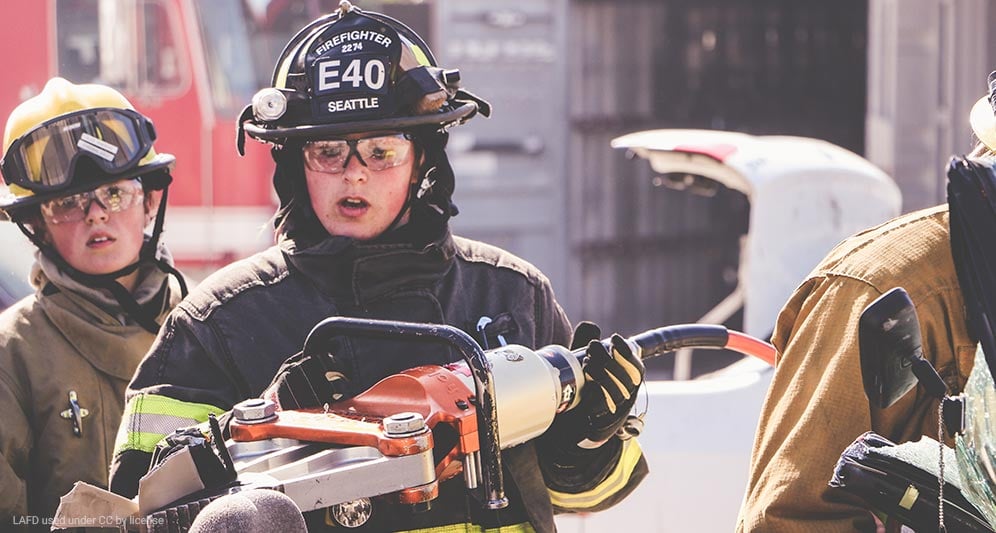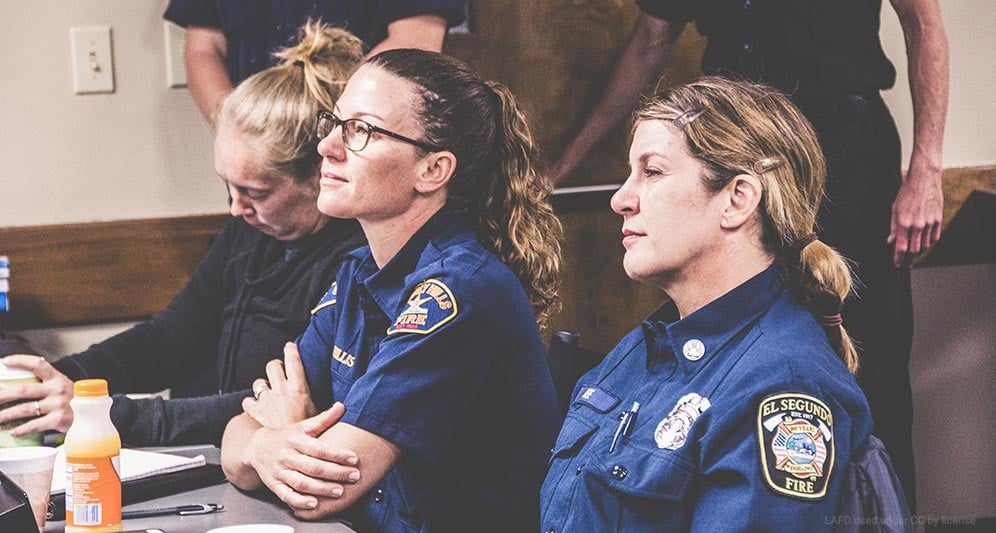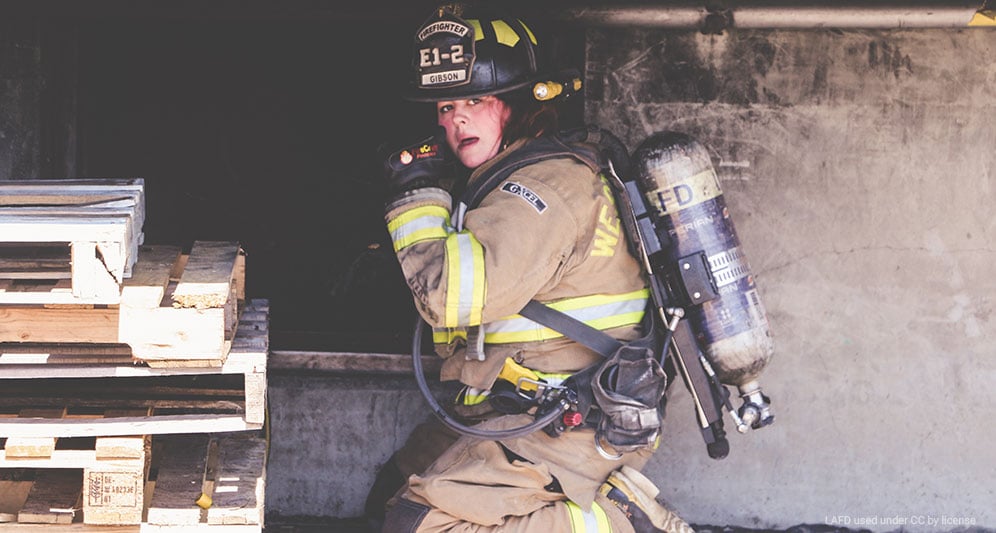Article highlights
- Realities of being a female firefighter.
- Writing more inclusive policies.
Many people still think of firefighting as a man’s job. It can be difficult for fire departments to recruit and retain women firefighters. And the fire service lags far behind other industries in employing women.
According to the National Fire Protection Association, women made up 9% of firefighters in the U.S. in 2020. That’s still significantly lower than the nearly 14% of full-time sworn officers in local police departments who were women that same year.
The macho culture of many fire departments can actually be harmful. For example, studies have shown that men in high-risk occupations tend to normalize and accept more risks.
On the other hand, women in the fire service may actually help improve firefighter safety.
A recent survey published in the Journal of Workplace Behavioral Health found that women firefighters are more likely to weigh the risks in dangerous situations, practice proper techniques, and ask for help when they need it.
Bringing in more diversity and shifting attitudes to value different perspectives can improve any fire department.
In order to attract and retain women in the fire service, departments must make sure their policies, practices, and facilities promote inclusivity.
Realities of Being a Female Firefighter
Firefighting is still a male-dominated profession. Women looking for careers in the fire service can face many frustrations and barriers. This can make it difficult for departments to recruit and retain female firefighters.
Ill-fitting gear
According to research by Dr. Meredith McQuerry and colleagues, published in Frontiers in Materials in 2023, 80% of female firefighters report issues with ill-fitting personal protective equipment (PPE), a rate four times higher than that of their male counterparts.
Sometimes, this problem arises when fire departments buy stock gear, or reissue gear without properly fitting it to the firefighters. This is problematic since women are shaped differently than men. Standard men’s sizes may not fit women.
But badly fitting gear is not only a matter of comfort. It’s also a matter of safety. Gear that is too loose or too tight can limit movement or allow in heat or harmful chemicals.
Lack of facilities
Many older firehouses were built just for men, with male bunk rooms, bathrooms, and showers. Sharing these facilities can be uncomfortable for women in the fire service.
Women in the fire service often have to find creative ways to sleep, shower, use the restroom, and change clothes comfortably. A 2021 study published in collaboration with the International Association of Women in Fire & Emergency Services found that 48% of women reported privacy issues in fire station facilities like bathrooms, changing areas, and dorms.

Barriers to promotions/advancement
Women in the fire service can tend to be less likely to seek promotion. Some simply feel like superiors won't promote them because of their gender. Others fear hostility or retaliation from male coworkers.
It has become less common to see openly discriminatory hiring practices in the fire service. But women in the fire service often feel the pressure not to stick out or attract criticism.
Dany Cotton, the first female commissioner of the London Fire Brigade, told The Guardian that she still gets criticism after nearly 30 years in the fire service.
“Mostly it’s comments from retired firefighters who think a woman can’t do the job, or that I only got the job because I’m a woman,” she said. “It doesn’t occur to them that I might be the best person to do the job.”
Work twice as hard
Women in the fire service can sometimes feel the need to prove themselves to their male co-workers.
In her interview, Cotton recalled how she felt when she first joined the fire service in 1988.
“It was very, very macho,” she said. “I had to prove myself twice over, four times over …. The issue for some is that if a woman can do the job, then it isn’t the big hero job it was. It de-machos their role.”
This constant need to validate their abilities can be both exhausting and isolating, especially in an environment where they may not always feel fully accepted or supported.
Harassment
According to FEMA’s handbook for female firefighters, up to 85% of women in the fire service have experienced some form of sexual harassment at work.
Sexual harassment can take the form of verbal abuse, inappropriate comments, or behavior that causes the victim to feel uncomfortable or intimidated.
In some cases, harassment is complicated and subtle. In others, it comes out overtly in physical aggression, inappropriate touch, or unwanted sexual advances.
Women in the fire service who experience harassment can feel hesitant to speak out about it for fear of being singled out, labeled as troublemaker, or even fired.

Writing More Inclusive Policies
The first step toward recruiting and retaining women in the fire service is creating a culture of excellence and inclusivity. This isn’t about being politically correct; it’s about creating a safe workplace where employees work as a team and things like harassment are not tolerated.
Building a healthy workplace culture starts with policies. Policies do more than lay out rules; they also promote values, integrity, and ethics.
As we wrote in our post about Creating a Culture of Ethics and Integrity in the Fire Service:
Ethics in the fire service are not a given. Even with the strong overall culture in the fire service, individual departments can become toxic places to work if a healthy culture isn’t maintained.
Fire departments must create and sustain a culture that encourages integrity, open communication, trust, and ethical behavior.
Fire service policies should help create an inclusive environment. Department leaders should take special care with policies in the following areas:
Anti-discrimination and harassment
Fire service policies should guard against discrimination in every aspect of hiring, training, promotions, and more. They should specify that every member of the department should be treated equally, regardless of gender.
Fire departments should also make sure that policies strictly prohibit discrimination and harassment.
FEMA’s handbook for managers in the fire service advises leaders to take a “zero tolerance” to inappropriate workplace behavior. The handbook includes some steps managers can take to prevent and deal with harassment:
- Create a clear, step-by-step procedure for filing complaints, and include a list of individuals and agencies where employees can bring complaints.
- Regularly train all personnel on interpersonal issues, including sexual harassment.
- Keep complaints confidential, and protect the victim and witnesses from retaliation.
- Quickly investigate complaints and, when necessary, discipline the harasser.
Responding effectively and quickly to claims of harassment will show that the department respects and values all employees. Effective anti-harassment policies will create a safer environment for all.
Training standards
All firefighters have to meet certain standards of knowledge and physical capability. But fire departments need to make sure the expectations and standards are reasonable and not discriminatory.
Some female firefighters may be smaller than their male co-workers, but they’re often still capable of the same tasks.
Women in the fire service have pushed back against using brute force to accomplish tasks. Instead, they emphasize proper technique and teamwork.
“I think where we [women] benefit too is with technique because other things can be a struggle,” said one participant in a study on women in the fire service.
“We use better technique, and a lot of guys get hurt because they just try to muscle it or god forbid that they ask somebody for help …. So a lot of guys will just muscle things that really would be more efficient as a two-person job.”
The FEMA handbook says firefighter policies and training should leave room for various methods instead of enforcing one way of doing a task.
Firefighters should be encouraged to perform a task in the way that is most efficient for them and gets the job done safely. Physical techniques for smaller, shorter firefighters should be incorporated wherever possible into physical skills and evolutions.
Different techniques should be demonstrated equally, without implying that one method is somehow inferior or should be used only if the recruit is having trouble with the “normal” or “regular” method.
The handbook includes other helpful advice for how to fairly and effectively train women in the fire service.
Equality in promotions
Fire service policies should clearly lay out the guidelines for promotions. Promotional opportunities should be based on who is qualified and right for the job, not who is most popular or well connected within the department.
Policies should ensure a fair process that is equal for all.

Pregnancy and childcare
Women in the fire service can feel wary that getting pregnant could result in them losing their job or status in the department. In order for women to truly feel welcome in the fire service, policies must address the needs of both men and women.
The FEMA handbook advises fire departments to address three different things in this area:
- Reducing reproductive risk for the pregnant employee, the breastfeeding employee, and the male or female employee attempting to conceive a child.
- Providing adequate leave for the woman during the time she is disabled as a result of childbirth.
- Providing adequate leave for new parents surrounding the birth or adoption of a child.
Hair and grooming standards
Fire departments have traditionally required firefighters to keep their hair short. Exposed hair can be a hazard on the fireground, and short hair is usually considered more professional for men.
However, various court cases have prohibited departments from requiring employees to conform to a certain hair length.
When creating policies for grooming standards, fire departments should be careful to use language that is equal for both genders. Only providing male grooming standards paints a picture that women are not welcome in the department.
FEMA encourages fire agencies to take into account the unique needs of their departments and to develop policies that prioritize safety over appearance. For example, some departments have adapted their grooming standards to ensure they support operational effectiveness without creating unnecessary barriers for women in the fire service.
Women in the fire service can be a tremendous asset to any department. With the number of women firefighters still so low, departments should actively look to recruit and retain women. One of the ways to do this is to make sure department policy speaks to the needs of female firefighters and fosters an inclusive environment.


